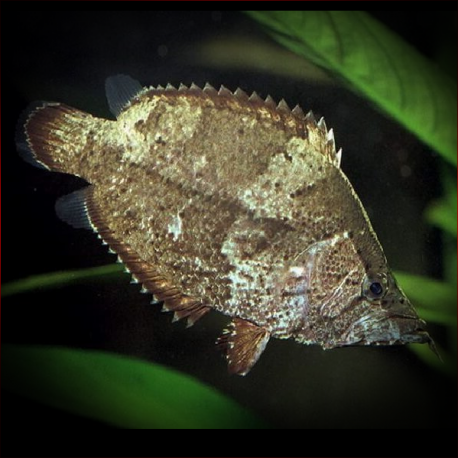More info
Datasheet
| Minimum Tank Size | 70 litres / 18.49 US gallons |
| Maximum Size | 10.0cm / 3.94inches |
| Temperature | 23°C / 73.40°F - 29°C / 84.20°F |
| Hardness | 1-10ºdH |
| pH | 5.0-6.8 |
General Description
Known as the South American Leaf Fish or Amazon Leaf Fish, the Monocirrhus polyacanthus is an expertly camouflaged species that mimics a dead leaf in body shape and pattern. It can change color to blend seamlessly with its surroundings and has a unique projection from its lower lip that resembles a leaf stalk. During hunting, it adopts a head-down stance, slowly approaching its prey resembling a drifting leaf, propelled by subtle movements of its transparent fins. When attacking, its mouth extends outward to form a tube, swiftly sucking in prey, often headfirst, in a nearly imperceptible motion. This species can consume prey almost equivalent to its own size with this method.
Aquarium Setup
For optimal care, soft acidic water conditions are crucial for M. polyacanthus. The tank should be dimly-lit, featuring floating plants to further soften the lighting. Heavy planting with broad-leaved varieties such as echinodorus is recommended to provide security for the nervous nature of this fish. Driftwood for hiding places should be included, with minimal water movement to mimic its natural habitat.
Behaviour
This species thrives best in a species tank; however, it can coexist with medium-sized loricariids and armoured catfish without major issues. Monocirrhus polyacanthus is a voracious carnivore that primarily consumes live food. It requires a piscivorous diet, typically sustained by a continuous supply of live feeder fish. Some individuals may adapt to live river shrimp but this is uncommon.
Feeding and Diet
As carnivorous predators, M. polyacanthus solely accepts live food, starting with bloodworms and small earthworms when young but transitioning to a piscivorous diet long-term. It is crucial to provide a consistent source of live feeder fish to match its daily consumption, which can amount to its body weight. Weaning onto live river shrimp is rare and not the norm for this species.
Reproduction & Dimorphism
Breeding M. polyacanthus in captivity is feasible with specific tank conditions. A densely planted breeding tank with soft, acidic water, warmth above 77°F, and subdued lighting is essential. During spawning, the male intensifies in color while the female displays an ovipositor. The process involves intricate courtship behavior and egg fertilization by the male. The eggs are typically laid on the underside of a large leaf or overhanging rock, with the male safeguarding them until hatching.
Habitat and Distribution
Inhabiting shallow, slow-moving water areas where fallen leaves accumulate, Monocirrhus polyacanthus is found in regions spanning Brazil, Peru, Venezuela, Colombia, and Bolivia.

